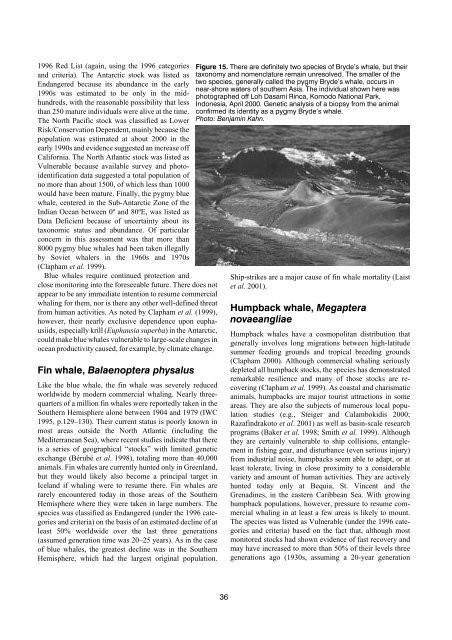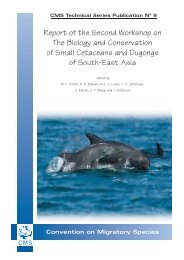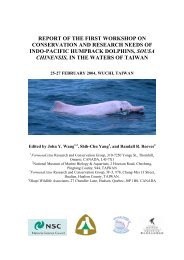Dolphins, Whales and Porpoises: 2002-2010 Conservation - IUCN
Dolphins, Whales and Porpoises: 2002-2010 Conservation - IUCN
Dolphins, Whales and Porpoises: 2002-2010 Conservation - IUCN
Create successful ePaper yourself
Turn your PDF publications into a flip-book with our unique Google optimized e-Paper software.
1996 Red List (again, using the 1996 categories<br />
<strong>and</strong> criteria). The Antarctic stock was listed as<br />
Endangered because its abundance in the early<br />
1990s was estimated to be only in the midhundreds,<br />
with the reasonable possibility that less<br />
than 250 mature individuals were alive at the time.<br />
The North Pacific stock was classified as Lower<br />
Risk/<strong>Conservation</strong> Dependent, mainly because the<br />
population was estimated at about 2000 in the<br />
early 1990s <strong>and</strong> evidence suggested an increase off<br />
California. The North Atlantic stock was listed as<br />
Vulnerable because available survey <strong>and</strong> photoidentification<br />
data suggested a total population of<br />
no more than about 1500, of which less than 1000<br />
would have been mature. Finally, the pygmy blue<br />
whale, centered in the Sub-Antarctic Zone of the<br />
Indian Ocean between 0º <strong>and</strong> 80ºE, was listed as<br />
Data Deficient because of uncertainty about its<br />
taxonomic status <strong>and</strong> abundance. Of particular<br />
concern in this assessment was that more than<br />
8000 pygmy blue whales had been taken illegally<br />
by Soviet whalers in the 1960s <strong>and</strong> 1970s<br />
(Clapham et al. 1999).<br />
Blue whales require continued protection <strong>and</strong><br />
close monitoring into the foreseeable future. There does not<br />
appear to be any immediate intention to resume commercial<br />
whaling for them, nor is there any other well-defined threat<br />
from human activities. As noted by Clapham et al. (1999),<br />
however, their nearly exclusive dependence upon euphausiids,<br />
especially krill (Euphausia superba) in the Antarctic,<br />
could make blue whales vulnerable to large-scale changes in<br />
ocean productivity caused, for example, by climate change.<br />
Fin whale, Balaenoptera physalus<br />
Like the blue whale, the fin whale was severely reduced<br />
worldwide by modern commercial whaling. Nearly threequarters<br />
of a million fin whales were reportedly taken in the<br />
Southern Hemisphere alone between 1904 <strong>and</strong> 1979 (IWC<br />
1995, p.129–130). Their current status is poorly known in<br />
most areas outside the North Atlantic (including the<br />
Mediterranean Sea), where recent studies indicate that there<br />
is a series of geographical “stocks” with limited genetic<br />
exchange (Bérubé et al. 1998), totaling more than 40,000<br />
animals. Fin whales are currently hunted only in Greenl<strong>and</strong>,<br />
but they would likely also become a principal target in<br />
Icel<strong>and</strong> if whaling were to resume there. Fin whales are<br />
rarely encountered today in those areas of the Southern<br />
Hemisphere where they were taken in large numbers. The<br />
species was classified as Endangered (under the 1996 categories<br />
<strong>and</strong> criteria) on the basis of an estimated decline of at<br />
least 50% worldwide over the last three generations<br />
(assumed generation time was 20–25 years). As in the case<br />
of blue whales, the greatest decline was in the Southern<br />
Hemisphere, which had the largest original population.<br />
Figure 15. There are definitely two species of Bryde’s whale, but their<br />
taxonomy <strong>and</strong> nomenclature remain unresolved. The smaller of the<br />
two species, generally called the pygmy Bryde’s whale, occurs in<br />
near-shore waters of southern Asia. The individual shown here was<br />
photographed off Loh Dasami Rinca, Komodo National Park,<br />
Indonesia, April 2000. Genetic analysis of a biopsy from the animal<br />
confirmed its identity as a pygmy Bryde’s whale.<br />
Photo: Benjamin Kahn.<br />
Ship-strikes are a major cause of fin whale mortality (Laist<br />
et al. 2001).<br />
Humpback whale, Megaptera<br />
novaeangliae<br />
Humpback whales have a cosmopolitan distribution that<br />
generally involves long migrations between high-latitude<br />
summer feeding grounds <strong>and</strong> tropical breeding grounds<br />
(Clapham 2000). Although commercial whaling seriously<br />
depleted all humpback stocks, the species has demonstrated<br />
remarkable resilience <strong>and</strong> many of those stocks are recovering<br />
(Clapham et al. 1999). As coastal <strong>and</strong> charismatic<br />
animals, humpbacks are major tourist attractions in some<br />
areas. They are also the subjects of numerous local population<br />
studies (e.g., Steiger <strong>and</strong> Calambokidis 2000;<br />
Razafindrakoto et al. 2001) as well as basin-scale research<br />
programs (Baker et al. 1998; Smith et al. 1999). Although<br />
they are certainly vulnerable to ship collisions, entanglement<br />
in fishing gear, <strong>and</strong> disturbance (even serious injury)<br />
from industrial noise, humpbacks seem able to adapt, or at<br />
least tolerate, living in close proximity to a considerable<br />
variety <strong>and</strong> amount of human activities. They are actively<br />
hunted today only at Bequia, St. Vincent <strong>and</strong> the<br />
Grenadines, in the eastern Caribbean Sea. With growing<br />
humpback populations, however, pressure to resume commercial<br />
whaling in at least a few areas is likely to mount.<br />
The species was listed as Vulnerable (under the 1996 categories<br />
<strong>and</strong> criteria) based on the fact that, although most<br />
monitored stocks had shown evidence of fast recovery <strong>and</strong><br />
may have increased to more than 50% of their levels three<br />
generations ago (1930s, assuming a 20-year generation<br />
36





